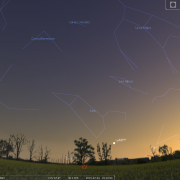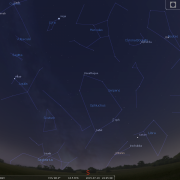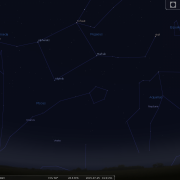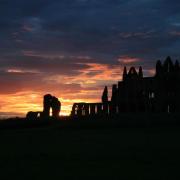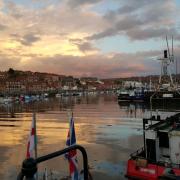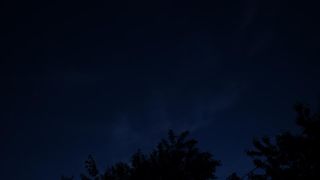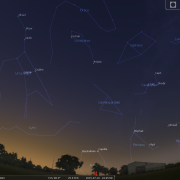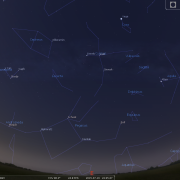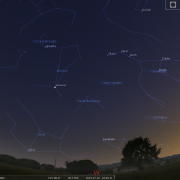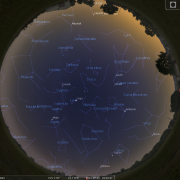Welcome to the WDAS monthly newsletter for July 2015: a digest of the month's latest contributions to our website. Below you'll find Society News, Sky Notes and In-Focus articles printed in full. There's also future events, and trailers for other articles which appear in full on the website - just a click away!
On the website you'll also be able to comment on articles, and if you'd like to play an editorial role in creating new content, just let us know!
Society News
Did anyone else notice a bright light flash outside - presumably in the sky, around 10:45pm -11pm on Wed 10th June. The light persisted for around 3 or 4 seconds and was roughly south in orientation, reasonbly high, but it was not directly visible. No sound was heard, so a bolide can be ruled out. It could have been a brilliant meteor. Anyone else notice anything?
In-Focus
Nights are now at their lightest and even the brightest stars are not visible before 10:30pm. The three most conspicuous stars (not planets) in the sky are Arcturus; visible high to the SSW, Vega; high to the NNE and Capella low to the north. Each of these summer luminaries may be regarded as being in our solar neighbourhood, some 36, 27 and 42 light years distant respectively.
The term ‘light year’ is often used to describe a stars distance, but is it a measurement of time, or distance? The answer to this could be ‘yes’ and ‘yes’, for there is a case that it applies to both. Certainly, a light year is used by astronomers as the standard measuring ‘yard stick’ with regard to stellar distances, but this in turn offers up some rather intriguing consequences as we shall see.
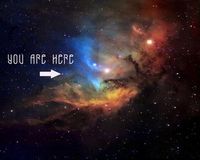 Space is big, no really; it is staggeringly vast, truly beyond human comprehension. Our closest neighbour, the Moon, is just under a quarter of a million miles away. To walk there would take approximately 6 years! Go by car and you could make the journey in approximately 6 months, a plane would reduce this to just under 20 days. The Saturn V rocket used for the Apollo missions made the trip in 3 days.
Space is big, no really; it is staggeringly vast, truly beyond human comprehension. Our closest neighbour, the Moon, is just under a quarter of a million miles away. To walk there would take approximately 6 years! Go by car and you could make the journey in approximately 6 months, a plane would reduce this to just under 20 days. The Saturn V rocket used for the Apollo missions made the trip in 3 days.
Our nearest star; the Sun, is approximately 93 million miles away and even if you could use the Saturn V rocket it would still require over 5 months before you became ‘toast’.
The space probe Voyager 1 was launched 38 years ago and travelling at over 25,000mph and some 20 billion Km from Earth, it is only now at the fringes of our known solar system. Put another way, that’s a ‘generation’ in time and yet we have barely made it out of our own “solar back yard”.
The nearest star system of Alpha Centauri is some 25 million, million miles away (25 trillion). Hitch a ride on Voyager and you would become quite bored after 100 thousand years of travelling. So, once outside the confines of our solar backyard, it becomes quite apparent that measuring space in miles or Km is quite meaningless.
A more convenient method is required and fortunately one exists; the speed of light. Light travels at a finite speed - 186,000 miles (300,000km) per second. In the time taken to read “THIS WORD”, light waves have travelled around Earth 7 times, and will travel almost 6 million million miles in one year. At such a speed the Moon is a mere 1.3 light seconds away, our Sun a handy 8.3 light minutes, and Neptune a manageable 4 hours. Voyager 1 is getting on for 30 hrs away.
Even at this speed it takes just over 4 years for light to reach us from our nearest stellar neighbours in the Alpha Centauri system, to be precise 4.23 light years.. just the nearest star. Hopefully, you have already made the connection, the remoteness of the stars also equates to a time dimension. How FAR light travels from a certain stellar object is also the same as how MANY years it takes to reach us. In effect because of the huge distances involved we view objects as they used to be.
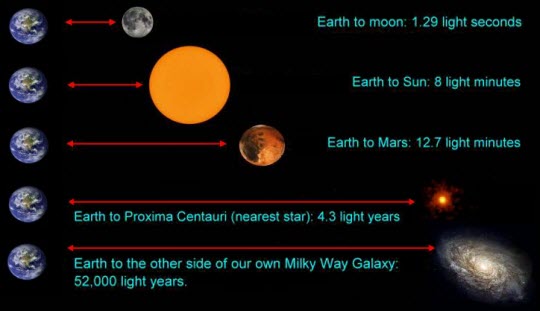
So when the next clear evening presents itself, and the brighter stars emerge, look for sparkling Vega, the brilliant star rising in the northeast. Its steely-blue light started its journey almost 27 years ago, the Soviets were withdrawing from Afghanistan and Ben Johnson was stripped of his 100m sprint Olympic gold medal in Seoul. Nine years earlier Margaret Thatcher became UK prime minister and the Soviets were just invading Afghanistan, when the light from Arcturus started out. Meanwhile the Glam Rock was in its heyday when photons from the binary star system of Capella set off.
Not all of the brighter summer stars are ‘close by’. For instance conspicuous Deneb, in Cygnus, currently climbing into the ENE, is a true cosmic searchlight. The light from the ‘swan’s tail’ is dimmed only by a journey spanning some 1700 light years! Gaze at Deneb and you see a star as it used to be when the Romans occupied Britain – and what did they ever do for us?! So if you want to become a time lord like Dr Who, then just fix your eyes on the heavens and trip the light fantastic.
After 9 years and billions of miles travelling, NASA’s New Horizons probe finally reaches Pluto in July. The mission goal is to understand the formation of the Pluto system, the Kuiper Belt, and the transformation of the early Solar System. The spacecraft will study the atmospheres, surfaces, interiors and environments of Pluto and its plethora of moons. It will also study other objects in the Kuiper Belt depending on which are in position to be explored.
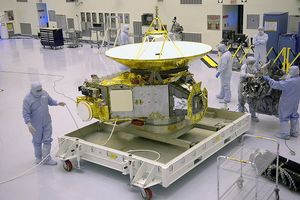 The spacecraft is comparable in size and general shape to a grand piano and has been compared to a piano glued to a cocktail bar-sized satellite dish.
The spacecraft is comparable in size and general shape to a grand piano and has been compared to a piano glued to a cocktail bar-sized satellite dish.
The overall cost of the mission is approximately $650 million over 15 years (2001–2016)
After several delays, New Horizons was launched on January 19, 2006, from Cape Canaveral, directly into an Earth-and-solar-escape trajectory. Because of the need to conserve fuel for possible encounters with Kuiper belt objects subsequent to the Pluto flyby, intentional encounters with objects in the asteroid belt were not planned. However, the New Horizons project team determined that by chance New Horizons would pass close to the tiny asteroid on June 13, 2006, close enough for detailed observations. The asteroid was estimated to be 2.5 km (1.6 miles) in diameter. Closest approach was 101,867 km (63,297 miles)
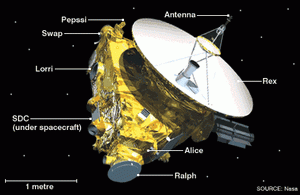 New Horizons then proceeded to Jupiter, making its closest approach on February 28, 2007 at a distance of 2.3 million kilometers (1.4 million miles). The planned Jupiter flyby provided a gravity assist that increased New Horizons 'speed 14,000 km/h; 9,000 mph to 83,000 km/h; 51,000 mph; shortening its voyage to Pluto by three years. Horizons crossed the orbit of Saturn on June 8, 2008, and Uranus on March 18, 201. Most of the post-Jupiter voyage was spent in hibernation mode to preserve on-board systems. On December 6, 2014, New Horizons was brought back on-line for the encounter, and instrument check-out began.
New Horizons then proceeded to Jupiter, making its closest approach on February 28, 2007 at a distance of 2.3 million kilometers (1.4 million miles). The planned Jupiter flyby provided a gravity assist that increased New Horizons 'speed 14,000 km/h; 9,000 mph to 83,000 km/h; 51,000 mph; shortening its voyage to Pluto by three years. Horizons crossed the orbit of Saturn on June 8, 2008, and Uranus on March 18, 201. Most of the post-Jupiter voyage was spent in hibernation mode to preserve on-board systems. On December 6, 2014, New Horizons was brought back on-line for the encounter, and instrument check-out began.
In January 2015, the New Horizons spacecraft began its approach phase to Pluto. Mission navigators are now attempting to position the probe; an imaginary rectangle in space measuring just 100 by 150 kilometres in order to ensure that the spacecraft can make all planned science observations during its fly-by of Pluto The last chance to change the spacecraft’s flight path comes on 4 July. When New Horizon’s slips by Pluto at 14km/sec it will need to quickly rotate its instruments to look at the surface. It will then continue on a precise path into the shadows of both Pluto and Charon, for its sole chance to look back and explore atmospheres on those worlds. The situation is so complex that New Horizons has, unusually, two navigation teams, and will choose the best option if their trajectory strategies are not consistent with one another. The whole thing is fraught with danger and will require precision and a slice of luck.
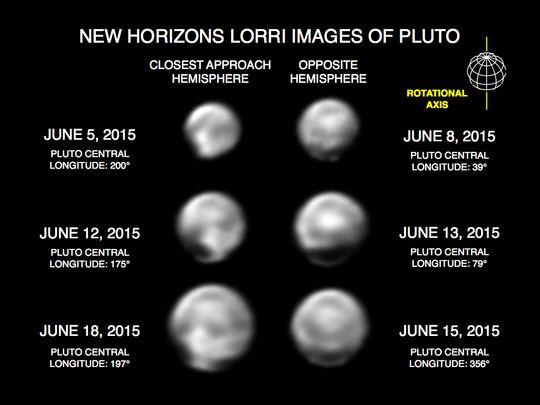
Approximately over 30 million km distant, New Horizons is already sending back tantalising images of Pluto and its chief moon Charon. These show mysterious bight and dark patches on Pluto and what appears to be a very dark polar cap on Charon, indicating a wide range of landscapes.
So, hold on to your hats, strap yourself in and keep everything crossed, it will undoubtedly be a very tense occasion, but hopefully a truly historic one.
You will be able to follow the mission via the Nasa web site, (and probably numerous others), it is also likely to feature widely across the media.
Mission break down
New Horizons’ fly-by of Pluto happens on July 14, 2015 at 11:50 UT, all of the most important goals for the mission occur in a 3 hour window, but it will not finish returning all of the data until late 2016.
The Pluto mission is divided into several phases:
- Approach Phase 1: 180 to 100 days before closest approach (Jan 6-Apr 4; range to Pluto is 226-121 million km). SWAP and PEPSSI will measure plasma. LORRI will monitor motions of Pluto, Charon, and the smaller moons. Pluto is barely resolved.
- Approach Phase 2: 100 to 21 days before closest approach (Apr 4-Jun 23; range to Pluto is 121-26 million km). Add in colour observations, and search for satellites and rings. The start of this phase is chosen to roughly coincide with the time when LORRI has better resolution than Hubble, but Pluto will still be only a few pixels across.
- Approach Phase 3: 21 to 1 days before closest approach (Jun 23-Jul 13; range to Pluto is 26-1.2 million km). Includes best, second-best, and third-best rotation coverage before closest approach, yielding the best global maps of Pluto and Charon. PEPSSI and SWAP may detect pickup ions and bow shock. LEISA and Alice can begin looking for variability in IR and UV. Search for clouds or hazes, tracking winds.
- Near Encounter Phase: -1 to +1 days (Jul 13-15, within 1.2 million km) — sequenced in 2008 and 2009. Most of the highest-priority observations.
- Departure Phase 1: 1 to 21 days after closest approach (Jul 15-Aug 4; range to Pluto is 1.2 to 24 million km). Remote sensing of Pluto and Charon is performed for only 1 rotation. SWAP and PEPSSI study magnetotail, pickup ions. REX studies night side temperatures. Nix and Hydra high-phase observations. Search for rings.
- Departure Phase 2: 21 to 100 days after closest approach (Aug 5-Oct 22; range to Pluto is 24 to 119 million km).
- Departure Phase 3: 100 to 180 days after (Oct 22-Jan 1, 2016; range to Pluto is 119 to 203 million km). No remote sensing observations planned.
Once it’s finished here, New Horizon will visit one or more Kuiper Belt Objects beyond Pluto.
Image Credits: NASA
Sky Notes
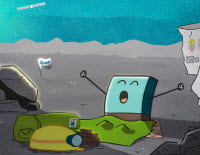 And here’s some more fantastic news, Rosetta's lander Philae has woken up after seven months in hibernation on the surface of Comet 67P/Churyumov-Gerasimenko, and by all acounts ‘is doing very well’.
And here’s some more fantastic news, Rosetta's lander Philae has woken up after seven months in hibernation on the surface of Comet 67P/Churyumov-Gerasimenko, and by all acounts ‘is doing very well’.
The signals were received at ESA's European Space Operations Centre in Darmstadt at 22:28 CEST on 13 June. For 85 seconds Philae "spoke" with its team on ground, via Rosetta, in the first contact since going into hibernation in November.
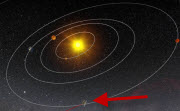
Rosetta on 01-Jul-2015
Inside orbit of Mars
When analysing the status data it became clear that Philae also must have been awake earlier: Scientists are now waiting for the next contact as there are still more than 8000 data packets in Philae’s mass memory which will give the DLR team information on what happened to the lander on the comet. Meanwhile the adventure continues as ESA have confirmed that its Rosetta mission will be extended until the end of September 2016, at which point the spacecraft will most likely be landed on the surface of Comet 67P.
By then as the comet moves far away from the Sun again, there will no longer be enough solar power to run Rosetta’s set of scientific instrumentation efficiently. Comet 67P/Churyumov-Gerasimenko will make its closest approach to the Sun on 13 August and Rosetta has been watching its activity increase over the last year.
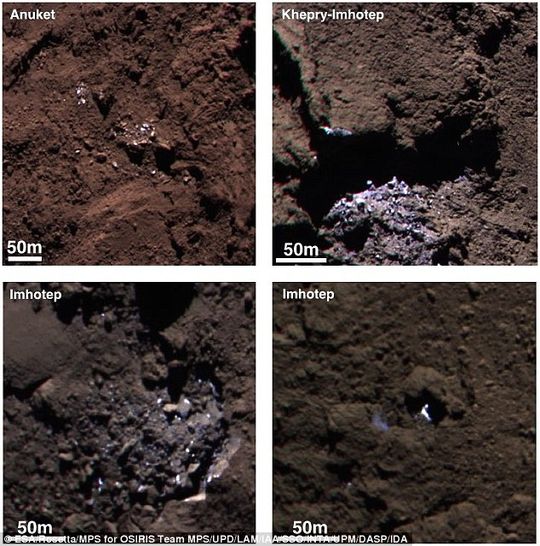
ESA has repleased the first pictures of possible ice on Comet 67P, taken by Rosetta
spacecraft in Sept-2015. Rosetta has found more than 100 patches
that could be water-ice, according to analysis of images from the probe.
Continuing its study of the comet in the year following perihelion will give scientists a fuller picture of how a comet’s activity waxes and wanes along its orbit. If Rosetta does land on the comet’s surface it is unlikely to be able to continue operations and relay data back to Earth, bringing to an end one of the most successful space exploration missions of all time.
Image Credits: ESA
In this month's Sky Notes:
Planetary Skylights

 Venus and Jupiter remain extremely close to each other at the start of July, appearing in the same field of view at low telescopic magnification. Venus, by far the brighter, will exhibit a distinct waning quarter phase. Jupiter will have its attendant Galilean moons close by (on the 1st Gamymede, Europa and Io will be on one side with Callisto very close to Jupiter on the other). On the 18th a slim crescent moon lies lower right of Venus. From mid-month onwards both planets become increasingly challenging to spot and are pretty much lost in twilight by the month's end.
Venus and Jupiter remain extremely close to each other at the start of July, appearing in the same field of view at low telescopic magnification. Venus, by far the brighter, will exhibit a distinct waning quarter phase. Jupiter will have its attendant Galilean moons close by (on the 1st Gamymede, Europa and Io will be on one side with Callisto very close to Jupiter on the other). On the 18th a slim crescent moon lies lower right of Venus. From mid-month onwards both planets become increasingly challenging to spot and are pretty much lost in twilight by the month's end.
 Saturn is visible low to the south, slowly moving backwards through Libra. A telescope is required to resolve the glorious ring system, which is orientated at its widest. The moon lies nearby on the 25th and 26th. Titan, Saturn’s largest moon will be visible on the eastern side of the planet on both nights.
Saturn is visible low to the south, slowly moving backwards through Libra. A telescope is required to resolve the glorious ring system, which is orientated at its widest. The moon lies nearby on the 25th and 26th. Titan, Saturn’s largest moon will be visible on the eastern side of the planet on both nights.

 The outer gas worlds of Uranus and Neptune are visible in the early morning hours in Pisces and Aquarius respectively. Earth is at Aphelion (furthest from Sun) on July 4th, a distance of around 95 million miles (152 million km)
The outer gas worlds of Uranus and Neptune are visible in the early morning hours in Pisces and Aquarius respectively. Earth is at Aphelion (furthest from Sun) on July 4th, a distance of around 95 million miles (152 million km)
Meteor Activity

The weak Ophiuchid meteor shower has two maxima, June 9th and June 20th. The zenith hourly rate (ZHR) barely exceeds sporadic levels (5 - 8 per hr) Observe post midnight. The poorly observed June Lyrids peak on the 15th/16th, again the ZHR is only 5-6 per hour.
Summer Solstice in Whitby
Summer Solstice photos submitted by WDAS Members. Click thumbnail for full-sized image.
|
Whitby Abbey on 21-Jun-2015
around 21:30h, taken by Mark. |
Whitby Abbey on 21-Jun-2015 |
|
Whitby Abbey on 21-Jun-2015
around 21:30h, taken by Mark. |
Whitby Harbour taken by Warren.
(Not exactly on Summer Solstice, but it's a fabulous photo!) |
A series of coronal mass ejection's (CMEs) hit Earth's magnetic field in the early morning hours of June 22nd, producing a severe G4-class geomagnetic storm and giving rise to quite a display of aurora (northern or southern lights).
Unfortunately much of the UK was clouded out and we missed out on the East coast. A second predicted display over the night of the 24/25th failed to live up to expectations, apparently taking place during daylight hours.
If you've sat out during the midnight hours of Summer twilight on Whitby's West Cliff looking for a hint of Aurora, you may wonder what you're hoping to recognise. This image taken by Martin McKenna is what you may see.
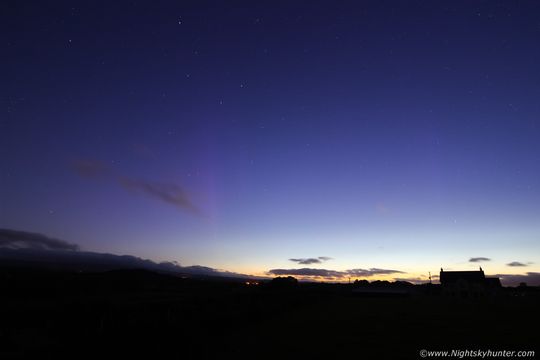
Aurora in Maghera, Northern Ireland on 22/23-Jun-2015 Captured by
Martin McKenna. Several purple rays over 40 degrees high can be seen to the left of centre
and above the house. (See Martin's photos at nightskyhunter.com). Click for full-sized image.
And here is Aurora captured in Wales by Huw James with a 15 second exposure.
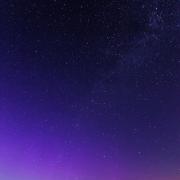
Aurora under Milky Way
Huw James 22-Jun-2015
Click for full-sized image.
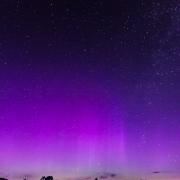
Aurora under Polaris
Huw James 22-Jun-2015
Click for full-sized image.
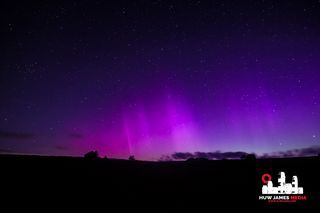
Aurora in the Brecon Beacons on 23-Jun-2015
Although Whitby was clouded out, Huw James captured
some amazing images (15s exposure). This one under
Ursa Major. (See Huw's photos on Flickr)
Click for full-sized image.
Now you know what you're looking for, see if you can pick out a hint of Aurora in Mark's photo.
Possible Aurora sighting, Whitby on 25-Jun-2105
This was two days after the big display captured
elsewhere in the UK. "Jury's out on this one", said
Mark. Click for full-sized image.
Even though we were unlucky in Whitby, as solar activity is quite high at present it is worth keeping a watchful eye on the sky and the Web, as further displays may be on the cards.
Useful link: Lancashire University Aurora Watch
Early/mid July is the optimum time in which a display of Noctilucent cloud may be visible. These delicate formations, filamentary in structure and having a characteristic silvery-blue colour, appear in the twilight sky above the northern horizon, long after sunset, even after midnight.
It forms almost exclusively between latitudes 50 and 60 degrees north, high in the upper atmosphere: 50 miles up- five times higher than normal clouds. The cloud forms when water vapour condenses at the low temperatures that prevail at such altitudes onto particles suspended in the air.
|
Looking South
Mid July - 22:45h |
Looking North |
|
Looking East
Mid July - 22:45h |
Looking West
Mid July - 22:45h |
|
|
|
|
Overview
Mid July - 22:35h |
|
Additional Image Credits:
- Planets and Comets where not otherwise mentioned: NASA
- Sky Charts: Stellarium Software
In the News
The Philae Lander on the usrface of comet P67, which went into battery-save hibernation in November, has woken up. That's according to this BBC report of the European Space Agency (ESA).
Events
 Observe the night sky with us at the Bruce Observatory, Whitby School
Observe the night sky with us at the Bruce Observatory, Whitby School
Observing Nights are held weather permitting: check for a relatively clear sky before leaving home. If in doubt, Mark can be reached on 07886069339
Please note the college drive gate is now operated via a electronic key code - so anyone wishing to attend must be at the car park at the top of the drive by 19:00hrs - unless an arrival time has been arranged with Mark/Keith.
 Whitby School - Room H1.
Whitby School - Room H1.
In Members' monthly meetings we usually take a tour of the night sky for the coming month using the Planetarium program. Have talks and presentations on various topics of astronomy/space etc, and discuss future events etc. New members welcome.
 Observe the night sky with us at the Bruce Observatory, Whitby School
Observe the night sky with us at the Bruce Observatory, Whitby School
Observing Nights are held weather permitting: check for a relatively clear sky before leaving home. If in doubt, Mark can be reached on 07886069339
Please note the college drive gate is now operated via a electronic key code - so anyone wishing to attend must be at the car park at the top of the drive by 19:00hrs - unless an arrival time has been arranged with Mark/Keith.
 Observe the night sky with us at the Bruce Observatory, Whitby School
Observe the night sky with us at the Bruce Observatory, Whitby School
Observing Nights are held weather permitting: check for a relatively clear sky before leaving home. If in doubt, Mark can be reached on 07886069339
Please note the college drive gate is now operated via a electronic key code - so anyone wishing to attend must be at the car park at the top of the drive by 19:00hrs - unless an arrival time has been arranged with Mark/Keith.

